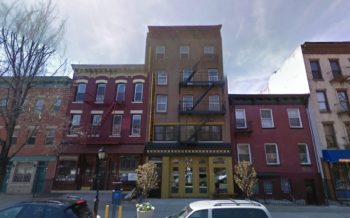
Center building at 338 Atlantic Avenue. Image Credit: Google Maps
Adjacent owner demanded that next-door neighbor remove fire escape that overhung the adjacent owner’s property. Clover M. Barrett owned a five-story mixed-use building, constructed in 1902, located at 338 Atlantic Avenue in Brooklyn. Barrett’s property had a fire escape dating from the original 1902 construction that hung three feet and five inches over a neighbor’s property located at 319-325 Pacific Street. The fire escape gave Barrett’s second through fifth floor tenants and building occupants the ability to escape or seek refuge on Pacific Street in the event of a fire. The neighboring property was originally a parking lot, but had recently been developed into townhouses. On October 15, 2014, the neighbor wrote Barrett a letter demanding that Barrett remove the fire escape.
Upon receiving the letter, Barrett sued the neighbor to establish an easement by prescription and to avoid having to remove the fire escape. The Supreme Court found no easement to protect the fire escape and dismissed the complaint. Barrett appealed.
The Appellate Division, Second Department, reversed, and remanded the case for trial. The court noted that the neighbor had established, prima facie, that there was no easement because the use had not hostile, but permissive, and because the fire escape did not interfere with the operation of the parking lot. In opposition, however, the Barrett had raised a triable issue of fact as to whether the use was hostile. Barrett pointed out that the fire escape, which hovered over a portion of the neighbor’s property, has been adverse, open and notorious, and continuous for the prescriptive period. The court ruled that there was a triable issue and that the case should be tried.
Barrett v. A&P Pac. Owner, LLC, 179 A.D.3d 883 (2d Dep’t 2020).
By: Jason Rogovich (Jason is a former CityLaw fellow and a New York Law School graduate, Class of 2019.)

